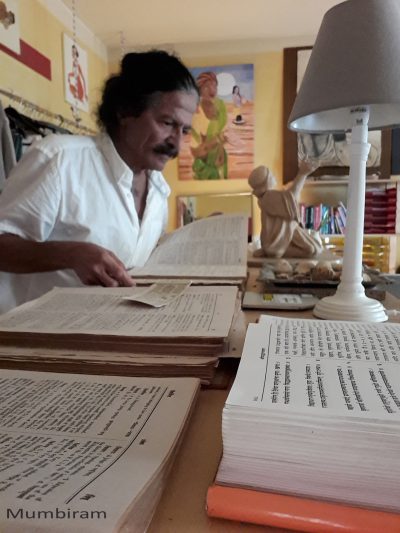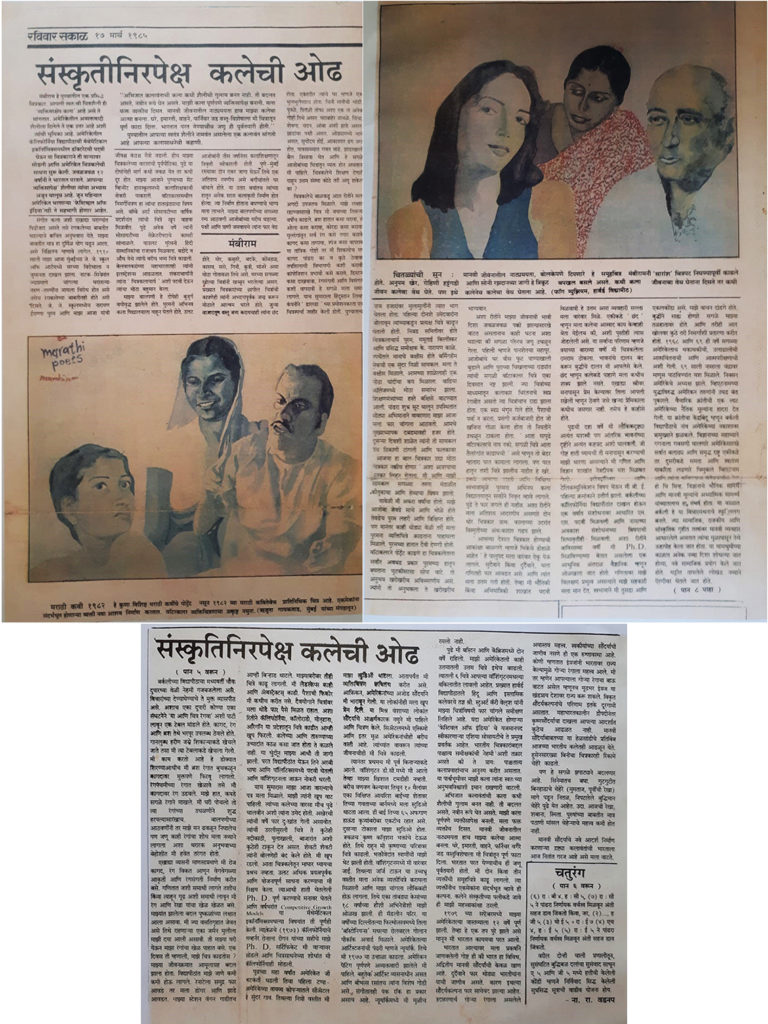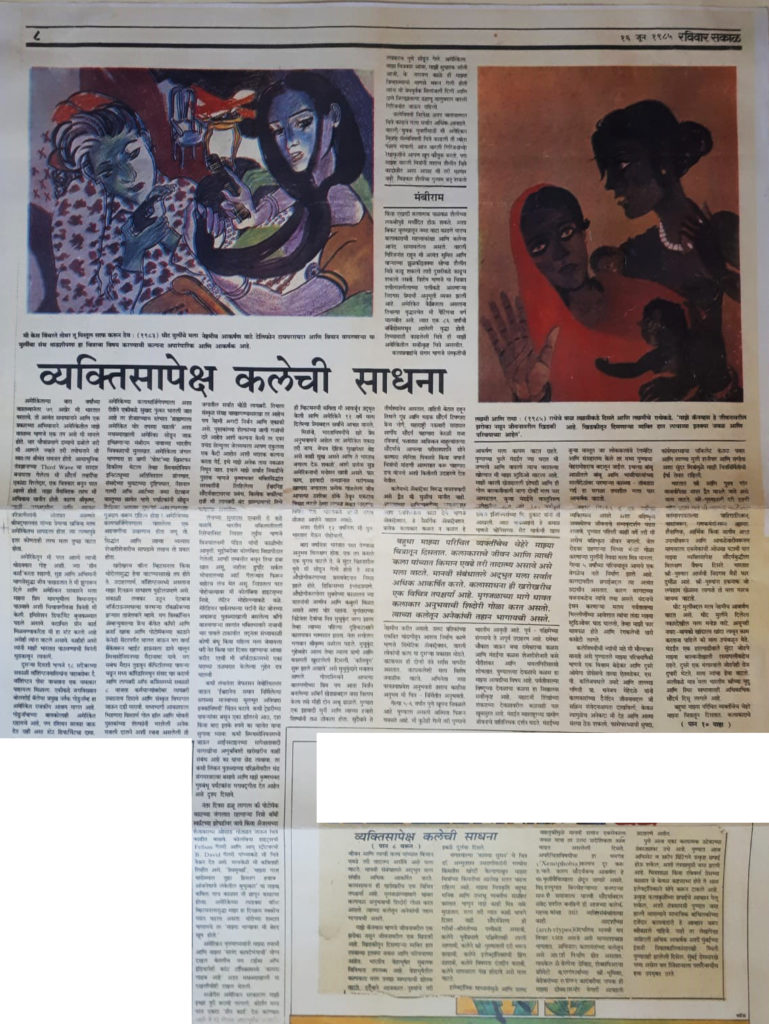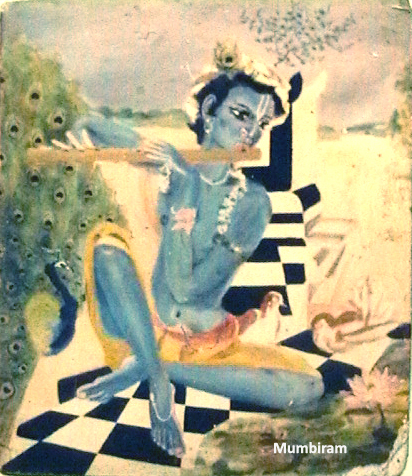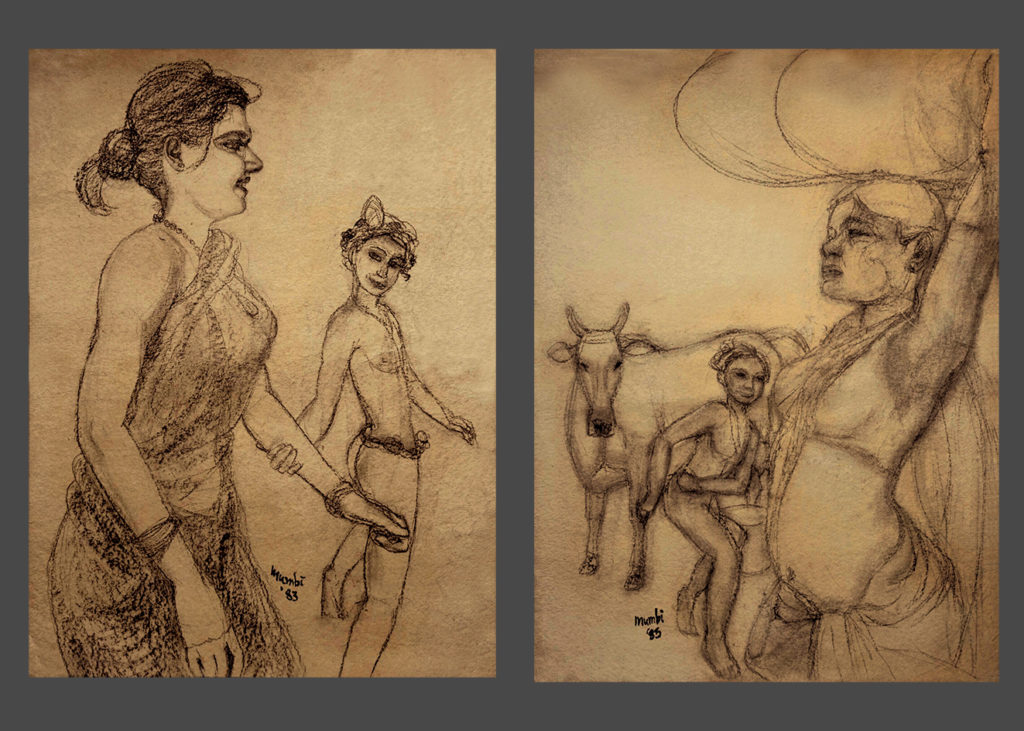Literary Artist
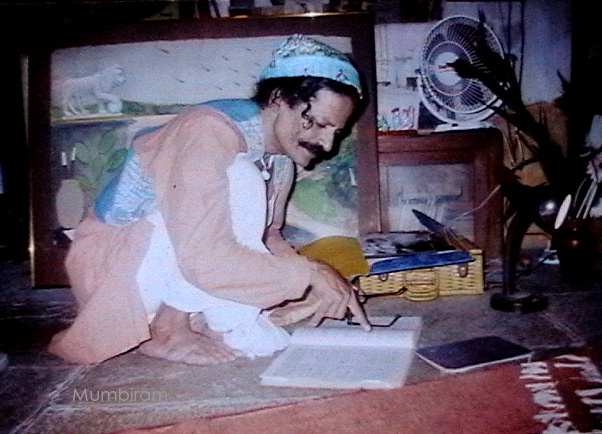
Beyond any doubt Artist Mumbiram is one of the most literary of contemporary painters. His perspective has the miraculous combination of a profound understanding of the timeless Indian Classics and a passion for innovation and originality in a painter’s life and craft.
Mumbiram’s art, as well as his writings about art, are as interesting as his life spent in search of beauty. For here is a man whose consciousness is inundated by the Aesthetic Choice. Here is a man who has walked the fire of self-exile before he ‘became’.
Here we are listing instances that come to our mind where Mumbiram’s literary skills were brilliantly displayed:
*** Mumbiram’s First Person Accounts published in Marathi ***
*** Evolution of the Idea of Personalist Art ***
*** Memorable quotations from Mumbiram ***
*** Article in Memory of Lakhuji ***
*** BookReaders – Love on Gutenberg Galaxy ***
*** Mumbiram’s Friendship with a Poet ***
*** References to Sanskrit Rasa Classics ***
*** High Five of Love – Ensemble of Rasa Art and Rasa Literature ***
In the following sections we will present in some detail each one of these memorable instances.
*** Mumbiram’s First Person Accounts published in Marathi ***
Mumbiram’s first person account articles “In Search of Art that transcends Culture” and “Practice of Personalist Art” have created a new dimension in contemporary Art Journalism. These engaging accounts, written in Marathi, were a happy change from the adjective-ridden staid fare that art columns of dailies and weeklies offer, which may bring accolades to the reviewer but never discover an artist. With a disarming lucidity in his writing Mumbiram describes his life spent in search of beauty in the US in the 70s as well as in beloved India after rejecting the coveted ‘green card’. Mumbiram’s writing invokes beautiful images in quick succession: a scholar walking to the library, a prisoner in a cellular jail, a man dancing to the bongo drums under a statue of St. Joan, an economist on the steps of the US Treasury, a devotee in the temple, an artist in the barn and so on.
An Aesthetic Search that has seen ‘Personlism’ blossom in Art, the very foundation of Rasa Renaissance.
*** Evolution of the Idea of Personalist Art ***
In Mumbiram, we have an artist with a full-fledged art movement to proclaim, something almost too much to have asked for. The idea of personalist art was first conceived and practised during Mumbiram’s sojourn of the north American continent in the 1960’s and 70’s.
This artist’s manifesto, which appeared first in 1988, gives us a glimpse of Mumbiram’s unique perspective on art. On the one hand, it contains courageous statements that deal with profound issues in the philosophy of art. On the other hand, they reveal the lofty position of a romantic, classical and idealistic artist. Equally importantly, they point to Rasa Rennaisance and the Prema Vivarta mood of relation to the Supreme Personality.
One clearly sees Mumbiram’s analytical mind and eloquent writing style at its spontaneous, articulate best in this lively writing. It is not just dry philosophy, but an expression of first-hand personal experiences. Wouldn’t that be the least you expect from a manifesto of personalism ?
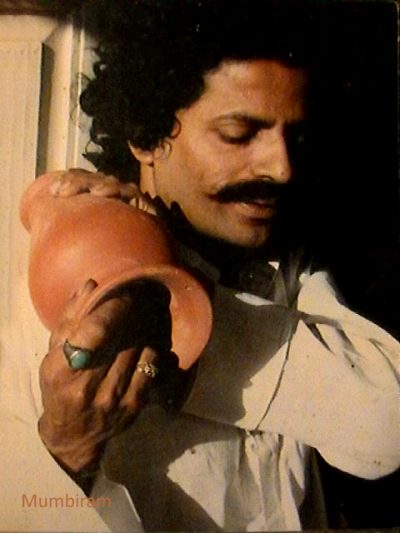
*** Memorable quotations from Mumbiram ***
Mumbiram’s art and writing are striking as confident, self-assured statements in an age of existentially unsure and apologetic stances. We have collected Mumbiram’s such memorable and striking statements as they appear in his first-person accounts of his artistic journey and also as we find them in a few rare interviews that he gave in the 1980’s.
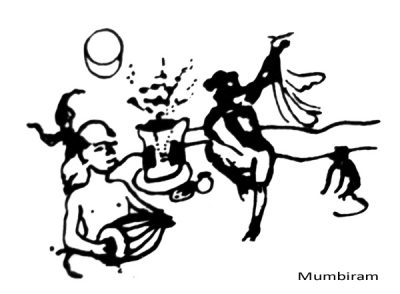
*** Article in Memory of Lakhuji ***
Mumbiram lived life guided by the principle of aesthetic choice about everything on every occasion and in every circumstance. In the context of Mumbiram’s personalist philosophy the aesthetics of human relationships was of prime importance. All of Mumbiram’s friendships were tested and appreciated for the Grace of the relationship. Mumbiram considered such friendships very precious. Mumbiram’s friendship with Lakhu was one such precious friendship. When fate brought this precious friendship to an abrupt end Mumbiram was deeply moved and spontaneously wrote this article as a tribute to a precious friend that he had lost.
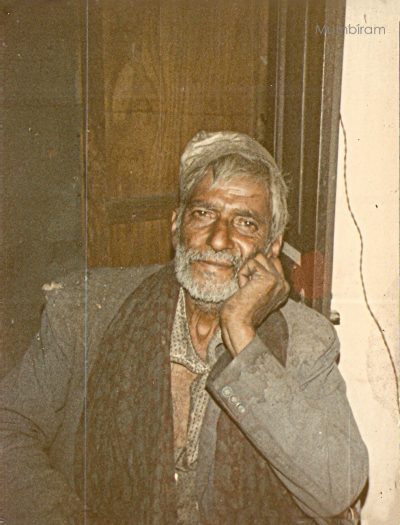
*** BookReaders – Love on Gutenberg Galaxy ***
Book Readers and Books are a recurring theme in Mumbiram’s paintings. The ensemble titled “Book Readers, Love on the Gutenberg Galaxy” captures the noble and global ideals that inspire this exceptional artist. Love is the constitutional rasa in Mumbiram’s poems as well as paintings.
In the Book Readers ensemble we see book reading as a very intimate sentimental experience, a blissful amorous happening that is ecstatic to all, crossing all cultural, ethnic or age barriers.
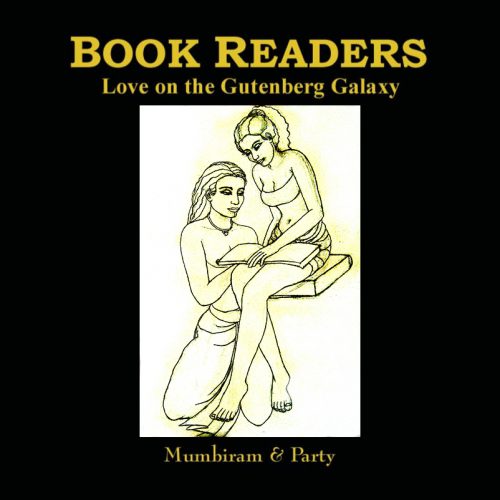
*** Mumbiram’s Friendship with a Poet ***
Mumbiram definitely has some favorite poets and favorite poems of the Marathi language. “Peacock Poet” Moropant is the earliest of them all. Mumbiram never tires of his Virat Parva and his Kekavali. “Aamhi Kon ?” of Keshavsut is an all time favorite. Balakavi is in a class of his own. Mumbiram finds N.V.Tilak’s “Aryabhoomi” awesome. Mumbiram is thrilled to hear Madhav Julian’s “Sangamotsuka Doha”. Ga.Di.Maa. has several extraordinary renderings that move Mumbiram. B.B.Borkar’s “Tethe kara majhe julati” has moved Mumbiram to tears. Mumbiram had liked certain lines of Mangesh Padgaonkar’s poetry. One of Padgaonkar’s colleagues once told Mumbiram that Padgaonkar had read and admired Mumbiram’s Marathi first person accounts that appeared in Ravivar Sakal in 1985.
Mumbiram’s connect with Manmohan Natu was something special and personal. Mumbiram made the ink-and-brush rendering of the two women friends of the Artist hovering over his body, entirely independently, for reasons of his own. He came to know of Manmohan’s poem about the dead poet only when Tatya Aitavdekar informed him about it. Mumbiram was so impressed that he wrote it on a screen print copy of this masterpiece. Mumbiram is glad that he came to know Manmohan and his poetry just at the right time.
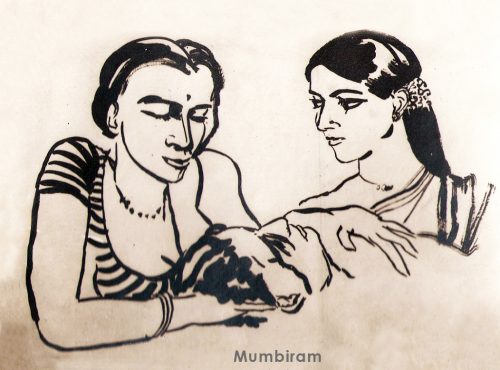
*** References to Sanskrit Rasa Classics ***
It has been said that in Mumbiram’s Rasa Art one hears reverberations of nectarean melodies of the ancient scriptures of India. Certainly his paintings are far more than just illustrations of existing texts.
*** High Five of Love – Ensemble of Rasa Art and Rasa Literature ***
Mumbiram has completed another ambitious project that he had undertaken after his first visit to Vrindavan in 1987.
He has rendered four great Rasa Classics in graceful English and contemporary idiom.Those were Sanskrit Literature of Vyasa’s “Rasa Panchadhyayi“, Jayadeva’s “Gita Govinda” and Vishvanath Chakravarty’s “Prema Samput” as well as a juicy folk version in Vraja Bhasha of Rupa Gosvami’s “LalitMadhava“. As English renderings of great eastern classics these are in the same league as Fitzgerald’s Rubaiyat of Omar Khayyam, Richard Francis Burton’s “Arabian Nights” or Edwin Arnold’s “Light of Asia”.
The fifth is Mumbiram’s original work “Deluges of Ecstasy” in the lofty Prema Vivarta mood of Love in Separation that he had composed in America.
All five of them are embellished with his masterpieces of Rasa Art.
These are published as a five volume ensemble “High Five of Love” by Distant Drummer Publishing of Germany. As literary classics illustrated by the author himself they are reminiscent of works of William Blake and Khalil Gibran.
A new aesthetic movement, uniting art and spirituality, is taking shape under the banner of Rasa Renaissance.
